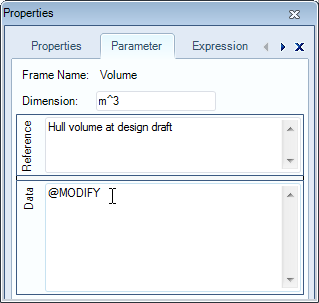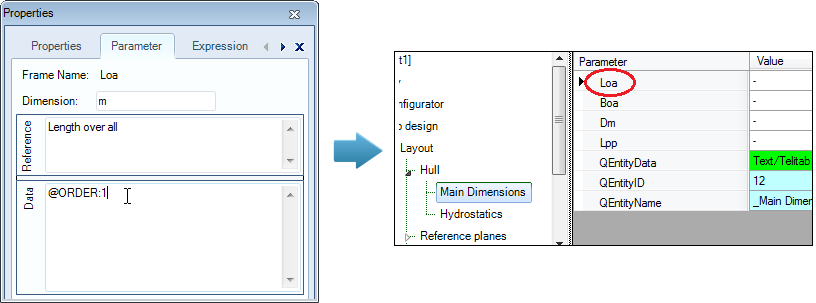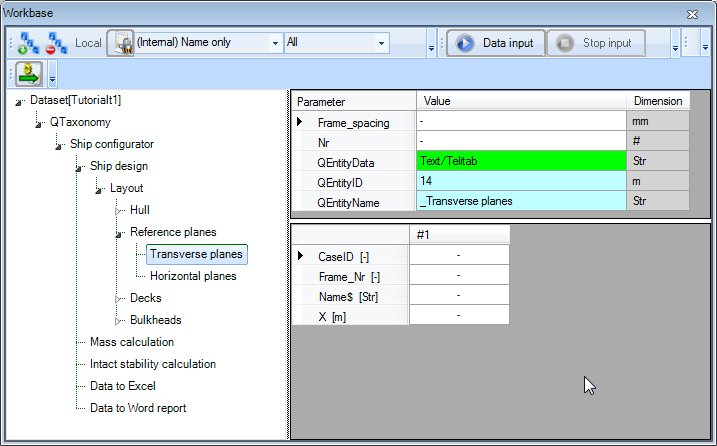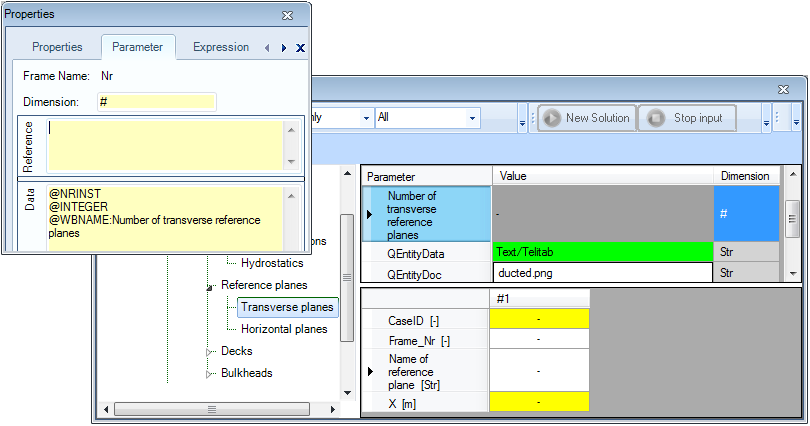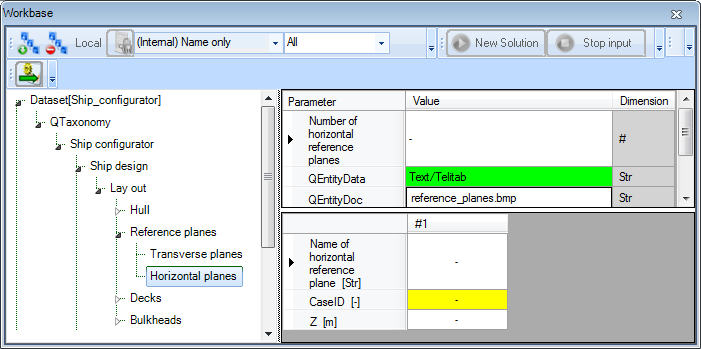1 Adding parameters to Transverse planes and Horizontal planes
The user must be able to define a table containing a number of transverse reference planes. In the Domain Expert tutorial, the purpose of entity Transverse planes is described in detail.
For each plane the user has to define a position and a name.
- Add the following parameters in the Knowledge Browser:
|
Parameter name |
Dimension |
Determined by |
Reference |
In Class |
|
|
[#] |
VR: User only |
Number of instances |
General |
|
|
[Str] |
VR: User only |
Name of object |
General |
|
|
[-] |
USR: User or system/equation |
Case index |
General |
|
|
[-] |
VR: User only |
Frame number |
General |
|
|
[mm] |
VR: User only |
Frame spacing |
Dimensions |
|
|
[m] |
VR: User only |
X position, in longitudinal direction |
Dimensions |
Z |
[m] | VR: User only | Z position, in vertical direction | Dimensions |
- Drag and drop parameters
Nr,Names$andCaseIDin bothHorizontal planesandTransverse planes. - Drag and drop parameters
Frame_Nr,Frame_spacingandXinTransverse planes. - Drag and drop parameter
ZinHorizontal planes.
2 Enable users to modify calculated values
In the Domain Expert version of the tutorial, it was shown that sometimes a user can modify calculated values after they are determined by the system. You, as a Knowledge Engineer, can enable this functionality by adding a @MODIFY attribute to the data slot of the parameter.
- Click on the parameter
Volumein the Knowledge Browser, select the Parameter tab of the Properties window and enter@MODIFYin the Data field.
3 Modify parameter display order
It can be desirable to influence the parameter display order in the Workbase list. Normally, Quaestor puts parameters in alphabetal order. An @ORDER attribute on a parameter defines the relative position of the parameter in the Workbase list. Define this position by: @ORDER:RelativePosition, in which RelativePosition is an integer. The @ORDER values need not be consecutive. Parameters are sorted on RelativePosition from low to high. Values with no @ORDER attribute are placed below parameters with @ORDER attributes.
Here, as an example, you will place parameter Loa at the top of the list. It is up to you to order the other parameters.
- Click on the parameter
Loain the Knowledge Browser, select the Parameter tab of the Properties window and enter@ORDER:1in the Data field.
4 Define minimum and maximum values for parameters
Another interesting feature to assist the user, is to provide feedback about minimum and maximum input values. Moreover, you can make these boundaries into hard ranges in order to prevent the user from providing values that might cause faulty results.
As an example, you can define a minimum and a maximum for the parameter Cb. This value must lie between 0 – 1.0. The system should issue a warning if the computed or input value is not within this range. This is done by means of the attributes @MAXVAL and @MINVAL. If you want the system to force a value inside this range, add @HARDRANGE as well.
- Add the following attributes to parameter
Cb:@MAXVAL:1.0,@MINVAL:0,@HARDRANGE
5 Have a parameter determine the number of cases in an entity
Parameter Nr will be used to indicate the number of cases (columns) in an entity.
- Provide parameter
Nrwith the special attribute @NRINST (Data field of Parameter tab in Properties window).
The @NRINST attribute tells Quaestor that the value given/calculated for this parameter indicates the number of instances/cases in an object (in this case an entity).
It is useful to also provide Nr with the attribute @INTEGER. The @INTEGER attribute limits input or computed values of the parameter to integer values. If a non-integer value is either computed or provided, the system issues a warning and prompts for other input or for new input of other parameter values that lead to this result. In addition, for this integer value you should change the number of decimal places to 0.
- Perform the necessary modifications.
6 Make parameters multicase
Normally, the value of any single value parameter is displayed in the list view.
The @MULTVAL attribute forces a single value parameter to present itself in table form. The @MULTVAL attribute is used in parameters if you wish to obtain a table which includes all values of these parameters whether they are single values or not. See also the Domain Expert tutorial.
The following parameters need to be shown in the table: Name$, CaseID, Frame_Nr and X.
- Set a @MULTVAL attribute on these parameters.
By doing this, you can see these parameters being moved from list view to table view (you might have to refresh Quaestor with Ctrl+U to redraw the Workbase).
7 Provide default values
- Create the following relation for parameter
Xin entityTransverse planesin the Workbase:
X = Frame_nr * (Frame_spacing/1000)
For each case, representing a transverse reference plane, this relation will be calculated. Parameter Frame_spacing does not have a @MULTVAL attribute, thus the value provided for Frame_spacing will be constant for each case.
It is possible to provide a default value for a parameter, that can be overruled by the user.
- Enter 700 in the Value cell of
Frame_spacing.
8 Use of ORCA() to generate case numbers
- Create the following relation for parameter
CaseIDin entityTransverse planesin the Workbase:
CaseID = ORCA(1)
The function ORCA(1) returns the current case number (during execution). Later on, this calculated value is used to refer to one of the transverse reference planes.
Incidentally, you could also have made this relation in the Knowledge Browser and connected it to entity's parameter.
9 Parameters to show extra information
Every entity is automatically created with three parameters, QEntityData, QEntityID and QEntityName. These are hidden from the user output by default. The first one can show behind-the-scenes computed values. In addition, parameters QEntityDoc and QEntityRef can also show extra information.
- Include
QEntityDocandQEntityRefin theHydrostaticsandTransverse planesentities by drag/drop from the Knowledge Browser. - Set the attribute @SHOW on
QEntityData,QEntityIDandQEntityName.
You can add a picture in QEntityDoc, which explains definitions of reference planes and the coordinate system of the vessel to the user in the Explanation window.
- Right-click on
QEntityDocin entityTransverse planesand select Taxonomy>Include Binary Data or press Ctrl+B. Select the file thet you want to include (e.g.reference_planes.bmp).
Comparable to assigning a reference to a parameter, you can assign a reference to an entity. As the value QEntityRef you can enter an unlimited entity reference text, which will be shown in the html Explanation window. For example; “Define number of transverse reference planes”
10 Make a parameter type local to an entity
You can use the @WBNAME parameter attribute to define a display name that differs from the name of the parameter itself. For example, you want to define a display name Number of transverse reference planes for parameter Nr. Because you want this name to be unique for entity Transverse planes you cannot simply add the attribute to the data slot of the parameter!
- Right-click on parameter
Nrin entityTransverse planesand select Taxonomy>Instantiate “Nr” (or press Ctrl+E).
Now, the background of this parameter's Properties window changes from white to light yellow. This means that you are now able to set properties and provide a reference text and attributes for the parameter which differ from the global reference text and attributes for this parameter.
You can restore the parameter to the global settings by again pressing Ctrl+E or selecting Taxonomy>Set global ”Nr” from the context menu.
After making parameter Nr in entity Transverse planes local in this way:
- Set the attribute
@WBNAME:Number of transverse reference planes - Change the reference text to
Number of transverse reference planes. - Do the same for parameter
Name$(make it local,@WBNAME:Name of, reference:transversereference planeName of transverse reference plane)
Remember that you can define a display sequence of the parameters in a specific entity by setting @ORDER attributes for localized parameters.
Finally the entity Transverse planes should look like this:
11 Completing Horizontal planes
Here is a summary of what to do to complete Horizontal planes in the same way.
The main goal here is that a user must be able define a table with a number of horizontal reference planes. For each plane the user must define a position and a name.
- Provide parameters
Z,CaseIDandName$with the attribute @MULTVAL. - Include the following parameters in entity
Horizontal planes:QEntityDocandQEntityRef. - Localize the parameters
NrandName$in entityHorizontal planesand provide for both parameters a @WBNAME attribute to define a display name. - Create the following relation
CaseID = ORCA(1).
This is the same relation as in VerticalPlanes' CaseID. You could also have used a global (defined in the Knowledge Browser) relation for both. Now both types of planes have each their own relation. In this example, their is not much difference. However, in more advanced usages, there are cases in which their is a significant difference.
- To show computed values, add the @SHOW attribute to behind
QEntityData. - Add a picture (e.g.
reference_planes.bmp) as Binary toQEntityDoc. - Assign the following text to
QEntityRef:Define number of horizontal reference planes.
Now your developed entity Horizontal planes should look something like this:
